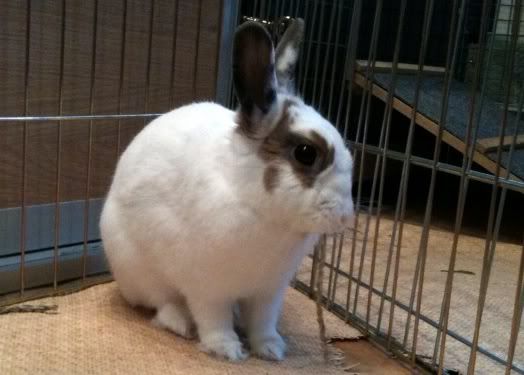kirbyultra
Well-Known Member
Toby had a stasis episode on Christmas Eve and he was building up a gut slowdown for weeks prior. He was look better in January. Feb was iffy, and March has not been so great. His poops have been furry strings of pearls at least twice a week. He has been shedding since, for as far back as I can recall, November 2009. Granted, he didn't shed much before that because he was a baby but is it normal for a bun at one yr old to continuously shed fur?
He doesn't have mites, I am certain of that. He just constantly sheds fur. Every day I vacuum up several big balls of white fur. And I really do vacuum daily due to me and my husband's allergies!
Toby is a dwarfy, mini rexy looking medium sized bun. He does not have Rex fur though. He used to eat alfalfa pellets made by oxbow but at around 8-9 months old I started to combine Timothy (also oxbow) pellets. He's finishing up the mixed pellets now and by April he and my Kirby will both be eating Timothy pellets. He only gets 1/8 cup a day. I used to give him 1/4 c but found him quickly getting quite pudgy so I reduced it. He's only 4.2 lbs anyway so a 1/4 c is a touch high... He eats Timothy and orchard hay. Regularly gets romaine and green lettuce and parsley as his staple salad.
I don't know why he is constantly shedding! I could pet him once and my hand would be covered with a thin layer of fur. If I groom him I think I could go on grooming him forever and there'd be more loose fur an hr later.... But he has a perfectly thick coat. He isn't thinning anywhere.
I'm just not sure if this is normal! He gets these weird poops which cause me to worry. But he is still eating fairly normally at least!
Advice?
Thanks!!
Helen
He doesn't have mites, I am certain of that. He just constantly sheds fur. Every day I vacuum up several big balls of white fur. And I really do vacuum daily due to me and my husband's allergies!
Toby is a dwarfy, mini rexy looking medium sized bun. He does not have Rex fur though. He used to eat alfalfa pellets made by oxbow but at around 8-9 months old I started to combine Timothy (also oxbow) pellets. He's finishing up the mixed pellets now and by April he and my Kirby will both be eating Timothy pellets. He only gets 1/8 cup a day. I used to give him 1/4 c but found him quickly getting quite pudgy so I reduced it. He's only 4.2 lbs anyway so a 1/4 c is a touch high... He eats Timothy and orchard hay. Regularly gets romaine and green lettuce and parsley as his staple salad.
I don't know why he is constantly shedding! I could pet him once and my hand would be covered with a thin layer of fur. If I groom him I think I could go on grooming him forever and there'd be more loose fur an hr later.... But he has a perfectly thick coat. He isn't thinning anywhere.
I'm just not sure if this is normal! He gets these weird poops which cause me to worry. But he is still eating fairly normally at least!
Advice?
Thanks!!
Helen





